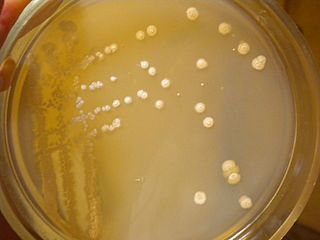Related Research Articles

Streptomyces is the largest genus of Actinobacteria and the type genus of the family Streptomycetaceae. Over 500 species of Streptomyces bacteria have been described. As with the other Actinobacteria, streptomycetes are gram-positive, and have genomes with high GC content. Found predominantly in soil and decaying vegetation, most streptomycetes produce spores, and are noted for their distinct "earthy" odor that results from production of a volatile metabolite, geosmin.
Amycolatopsis is a genus of high GC-content bacteria within the family Pseudonocardiaceae. The genus is known for producing many types of antibiotics, including
Streptomyces capoamus is a bacterium species from the genus of Streptomyces which has been isolated from soil from Iceland. Streptomyces capoamus produces capomycin, ciclamycin O, ciclamycin 4, anthracycline, ciclacidin A, ciclacidin B and ciclamicin.
Streptomyces chrestomyceticus is a bacterium species from the genus of Streptomyces. Streptomyces chrestomyceticus produces lycopene, pyrrolostatin, paromomycin, aminocidin, aminosidin, neomycin E and neomycin F.
Streptomyces coeruleorubidus is a bacterium species from the genus of Streptomyces which has been isolated from marine sediment. Streptomyces coeruleorubidus produces the following medications: pacidamycin 1, baumycin B1, baumycin B2, baumycin C1, feudomycin A, feudomycin B, feudomycin C, ficellomycin, feudomycinone A, and rubomycin.

Streptomyces gardneri is a bacterium species from the genus of Streptomyces. Streptomyces gardneri produces thiopeptide A, proactinomycin A, proactinomycin B, proactinomycin C.
Streptomyces griseoaurantiacus is a thermotolerant bacterium species from the genus of Streptomyces which was isolated from marine sediment. Streptomyces griseoaurantiacus produces the antibiotics manumycin, diperamycin and chinikomycin, and griseolic acid.
Streptomyces halstedii is a bacterium species from the genus of Streptomyces which has been isolated from deeper soil layers. Streptomyces halstedii produces magnamycin B, vicenistatin deltamycin A2, deltamycin A3, bafilomycin B1 and bafilomycin C1. Streptomyces halstedii also produces complex antifungal antibiotics like oligomycins and the antibiotics anisomycin and sinefungin.
Streptomyces microflavus is a bacterium species from the genus of Streptomyces which has been isolated from soil. Streptomyces microflavus produces nemadectin, fattiviracin A1, milbemycin and deoxyuridines. Streptomyces microflavus also produces the ionophore valinomycin. Streptomyces microflavus is also known to cause potato common scab disease in Korea.
Streptomyces nigrescens is a bacterium species from the genus of Streptomyces which has been isolated from soil. Streptomyces nigrescens produces 5-alkyl-1,2,3,4-tetrahydroquinolines and the antibiotics phoslactomycin A - F.
Streptomyces pseudovenezuelae is a bacterium species from the genus of Streptomyces which has been isolated from lead polluted soil in China. Streptomyces pseudovenezuelae produces chloramphenicol and setomimycin.
Streptomyces rishiriensis is a bacterium species from the genus of Streptomyces which has been isolated from soil in Hokkaido in Japan. Streptomyces rishiriensis produces coumermycin A1, notomycin, 2-chloroadenosine, phosphophenylalanarginine and lactonamycin.
Streptomyces rochei is a bacterium species from the genus of Streptomyces which has been isolated from soil in Russia. Streptomyces rochei produces borrelidin, butyrolactol A, butyrolactol B, uricase and streptothricin. Streptomyces rochei has antifungal activity against Fusarium oxysporum f.sp. lycopersici and Aspergillus fumigatus.
Streptomyces roseiscleroticus is a bacterium species from the genus of Streptomyces which has been isolated from soil from the Gujarat State in India. Streptomyces roseiscleroticus produces sultriecin.
Streptomyces sanglieri is a bacterium species from the genus of Streptomyces which has been isolated from soil from a hay meadow. Streptomyces sanglieri produces the antibiotic lactonamycin Z.
Streptomyces tateyamensis is a bacterium species from the genus of Streptomyces which has been isolated from the sponge Haliclona from the pacific coastline of the city Tateyama in the Chiba prefecture in Japan. Streptomyces tateyamensis produces the antibiotic thiopeptin B.
Streptomyces violaceusniger is a bacterium species from the genus of Streptomyces. Streptomyces violaceusniger has antifungal activity. Streptomyces violaceusniger produces isoafricanol and spirofungin.
Streptomyces lasiicapitis is a bacterium species from the genus of Streptomyces which has been isolated from the head of the ant Lasius fuliginosus. Streptomyces lasiicapitis produces the antibiotic kanchanamycin.
Streptomyces lydicamycinicus is a bacterium species from the genus of Streptomyces. Streptomyces lydicamycinicus produces the antibiotic lydicamycin.
Lydicamycin is an organic compound with the molecular formula C47H74N4O10. Lydicamycin is an antibiotic with activity against Gram-positive bacteria. The bacteria Streptomyces lydicamycinicus and Streptomyces platensis produces lydicamycin.
References
- 1 2 LPSN bacterio.net
- ↑ Straininfo of Streptomyces echinoruber
- 1 2 Deutsche Sammlung von Mikroorganismen und Zellkulturen
- ↑ UniProt
- ↑ Palleroni, NJ; Reichelt, KE; Mueller, D; Epps, R; Tabenkin, B; Bull, DN; Schüep, W; Berger, J (December 1978). "Production of a novel red pigment, rubrolone, by Streptomyces echinoruber sp. nov. I. Taxonomy, fermentation and partial purification". The Journal of Antibiotics. 31 (12): 1218–25. doi: 10.7164/antibiotics.31.1218 . PMID 738965.
- ↑ Socaciu, Carmen, ed. (2008). Food colorants chemical and functional properties. Boca Raton: CRC Press. ISBN 978-1-4200-0928-6.
- ↑ Roberts, edited by B.W. Bycroft ; contributors, A.A. Higton, A.D. (1988). Dictionary of antibiotics and related substances. London: Chapman and Hall. ISBN 0-412-25450-6.
{{cite book}}:|first1=has generic name (help)